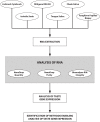A Comparison of Collection Techniques for Gene Expression Analysis of Human Oral Taste Tissue
- PMID: 27010324
- PMCID: PMC4807031
- DOI: 10.1371/journal.pone.0152157
A Comparison of Collection Techniques for Gene Expression Analysis of Human Oral Taste Tissue
Abstract
Variability in human taste perception is associated with both genetic and environmental factors. The influence of taste receptor expression on this variability is unknown, in part, due to the difficulty in obtaining human oral tissue that enables quantitative expression measures of taste genes. In a comparison of six current techniques (Oragene RNeasy Kit, Isohelix swab, Livibrush cytobrush, tongue saliva, cheek saliva collection, and fungiform papillae biopsy), we identify the fungiform papillae biopsy is the optimal sampling technique to analyse human taste gene expression. The fungiform papillae biopsy resulted in the highest RNA integrity, enabling amplification of all the assessed taste receptor genes (TAS1R1, TAS1R2, TAS1R3, SCNN1A and CD36) and taste tissue marker genes (NCAM1, GNAT3 and PLCβ2). Furthermore, quantitative expression was observed in a subset of taste genes assessed from the saliva collection techniques (cheek saliva, tongue saliva and Oragene RNA kit). These saliva collection techniques may be useful as a non-invasive alternative sampling technique to the fungiform papillae biopsy. Identification of the fungiform papillae biopsy as the optimal collection method will facilitate further research into understanding the effect of gene expression on variability in human taste perception.
Conflict of interest statement
Figures


References
-
- Mueller KL, Hoon MA, Erlenbach I, Chandrashekar J, Zuker CS, Ryba NJP. The receptors and coding logic for bitter taste. Nature. 2005;434(7030):225–9. - PubMed
-
- Kim UK, Jorgenson E, Coon H, Leppert M, Risch N, Drayna D. Positional cloning of the human quantitative trait locus underlying taste sensitivity to phenylthiocarbamide. Science. 2003;299(5610):1221–5. - PubMed
Publication types
MeSH terms
LinkOut - more resources
Full Text Sources
Other Literature Sources
Research Materials
Miscellaneous

